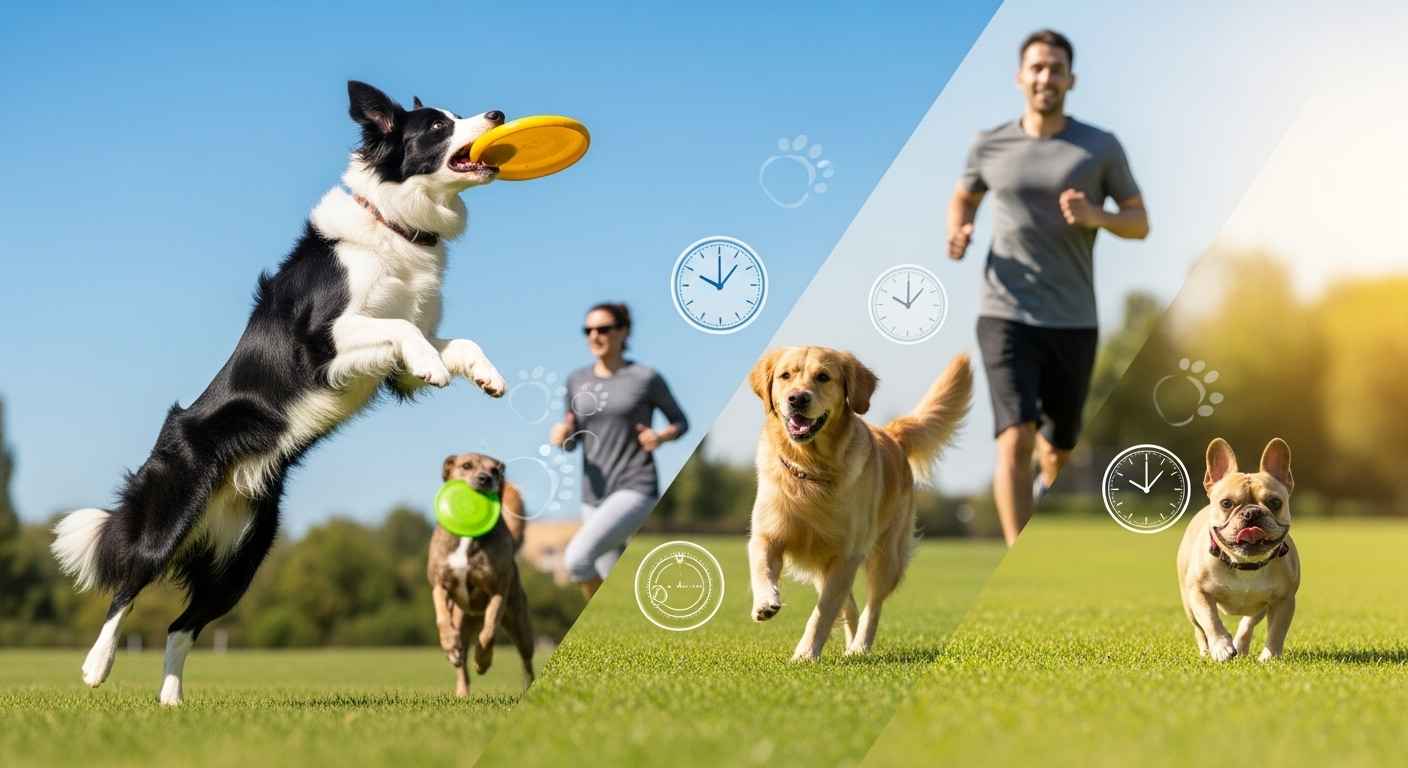Every dog owner asks this question at some point. The answer isn’t the same for every dog. Your Border Collie needs much more activity than your French Bulldog. Understanding your dog’s specific exercise needs keeps them healthy, happy, and well-behaved.
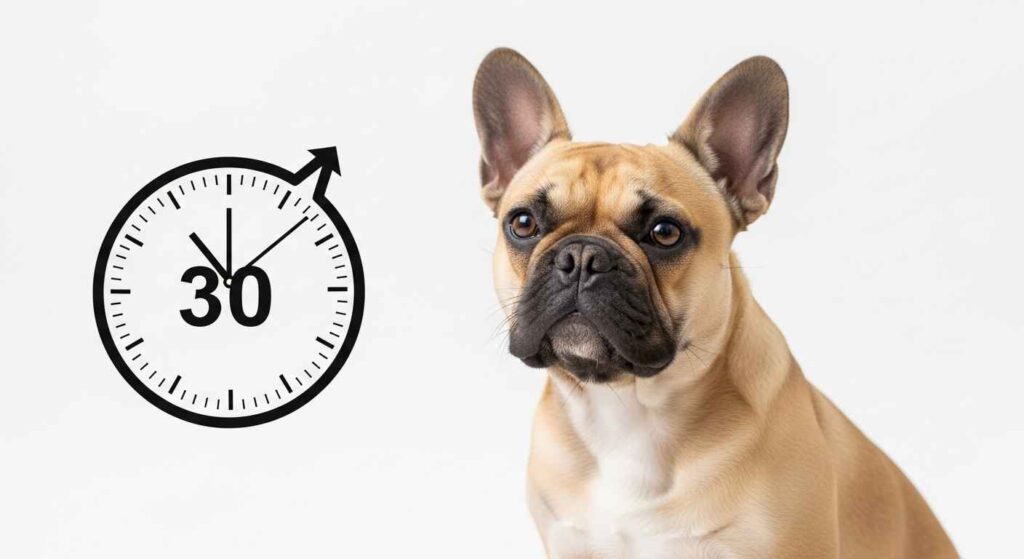
General Exercise Guidelines for Dogs
Most dogs need between 30 minutes to 2 hours of daily exercise. This includes walks, playtime, training sessions, and mental stimulation activities.
Here’s what counts as exercise for dogs:
- Walking and hiking
- Playing fetch or tug-of-war
- Swimming
- Running or jogging
- Training sessions
- Interactive games and puzzles
- Playing with other dogs
The key is consistency. You should take your pet for a walk at least once a day at around the same time.
Exercise Requirements by Dog Breed Groups
High-Energy Working and Herding Breeds
Daily Exercise Need: 90-120+ minutes
These breeds were developed for demanding jobs. They have incredible stamina and need substantial daily activity.
Breeds in this category:
- Border Collie
- Australian Shepherd
- German Shepherd
- Belgian Malinois
- Siberian Husky
- Jack Russell Terrier
High-energy dogs like Border Collies, Australian Shepherds, and Vizslas often enjoy 30–60 minute power workouts with plenty of mental stimulation. But many need even more than this baseline.
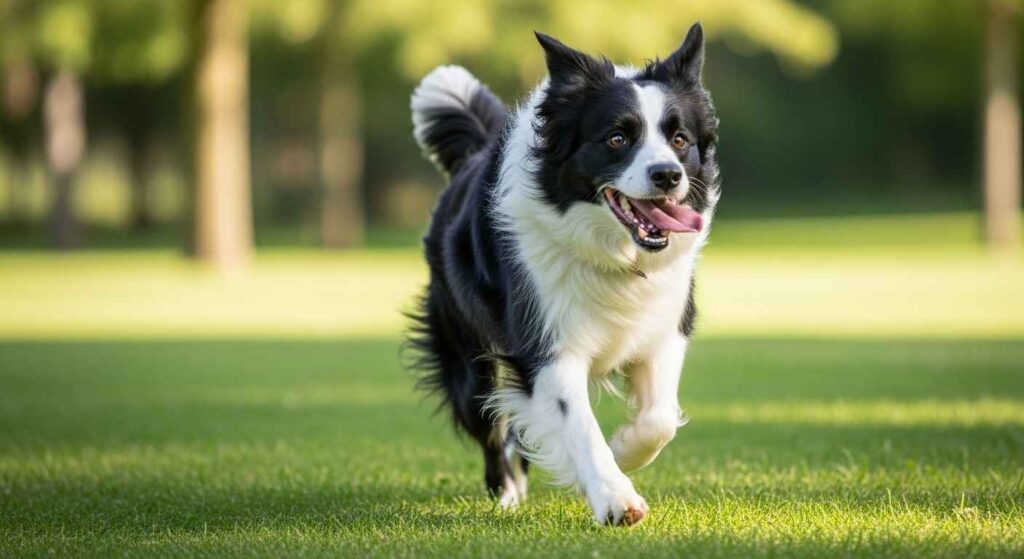
Moderate-Energy Sporting and Hound Breeds
Daily Exercise Need: 60-90 minutes
Research shows that gundog and hound breeds thrive on lots of activity. These dogs were bred for endurance hunting and retrieving.
Breeds in this category:
- Golden Retriever
- Labrador Retriever
- Beagle
- Pointer breeds
- Setter breeds
- Rhodesian Ridgeback
These dogs do well with two solid walks plus playtime. Many love swimming, which provides excellent exercise.
Low to Moderate-Energy Breeds
Daily Exercise Need: 30-60 minutes
Most companion breeds fall into this category. They enjoy activity but don’t require intense exercise sessions.
Breeds in this category:
- Cocker Spaniel
- Cavalier King Charles Spaniel
- Shih Tzu
- Boston Terrier
- Pug (with caution for breathing)
Low-Energy and Brachycephalic Breeds
Daily Exercise Need: 20-45 minutes
If your dog is a short-nosed breed, like a Bulldog, he will not tolerate a lot of daily exercise once he is fully grown.
Breeds in this category:
- English Bulldog
- French Bulldog
- Pekingese
- Basset Hound
- Mastiff breeds
These dogs overheat easily. Short, gentle walks work best. Avoid exercise during hot weather.
Exercise Requirements by Dog Age
Puppy Exercise (8 weeks – 18 months)
Puppies often exercise in short spurts, followed by a nap to recharge. Young puppies shouldn’t do forced exercise like long runs.
General rule: 5 minutes of exercise per month of age, twice daily. A 4-month-old puppy needs about 20 minutes of exercise twice per day.
Best puppy exercises:
- Short walks (10-20 minutes)
- Free play in a secure area
- Basic training sessions
- Socialization activities
- Gentle games
Important: Avoid repetitive high-impact activities until growth plates close (12-18 months depending on breed size).
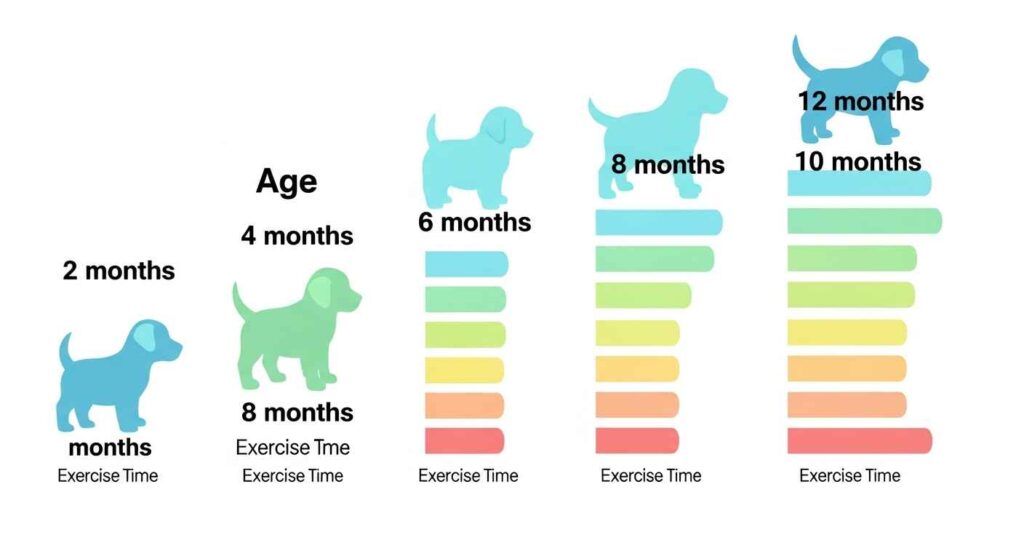
Adult Dog Exercise (1-7 years)
Young adult dogs have the highest exercise needs. This is when dogs have peak energy and stamina.
Exercise focus:
- Regular daily walks
- Active playtime
- Training and mental stimulation
- Adventure activities like hiking
- Dog sports if interested
Adult dogs can handle longer, more intense exercise sessions. Match the intensity to your dog’s breed and fitness level.
Senior Dog Exercise (7+ years)
Even if your dog is considered senior, you’ll still want to give them at least 30 minutes of daily exercise. The key is adjusting intensity and duration.
Senior-friendly exercises:
- Short, controlled walks on grass or softer surfaces are a good way for seniors to keep their joints and muscles less stiff
- Swimming (gentle on joints)
- Light play sessions
- Mental stimulation games
- Physical therapy exercises if needed
An elderly, small-breed dog might be happy with a 15-minute walk twice a day. Watch for signs of fatigue and adjust accordingly.
Exercise Requirements by Dog Size
Large Dogs (50+ pounds)
Large dogs typically need more total exercise time but can often handle longer, steady activities. They benefit from:
- Longer walks (45-90 minutes total daily)
- Hiking and trail walking
- Swimming
- Playing in large, open spaces
Medium Dogs (25-50 pounds)
Medium dogs are often the most versatile in exercise needs:
- 30-60 minutes of daily activity
- Mix of walks and active play
- Good candidates for dog sports
- Enjoy variety in activities
Small Dogs (under 25 pounds)
Small dogs can meet exercise needs with:
- Shorter but more frequent walks
- Indoor play sessions
- Quick outdoor playtime
- Mental stimulation activities
Remember: small legs mean more steps to cover the same distance.

Signs Your Dog Needs More Exercise
A pup that does not get enough physical activity will let you know in surprising ways, including destructive behaviors like digging, chewing, or marking.
Watch for these warning signs:
- Excessive barking or whining
- Destructive chewing or digging
- Hyperactivity or restlessness
- Weight gain
- Attention-seeking behaviors
- Difficulty settling down
- Pulling excessively on walks
These behaviors often improve significantly with adequate exercise.
Types of Exercise for Dogs
Physical Exercise
- Walking: The foundation of dog exercise
- Running/Jogging: For high-energy, healthy adult dogs
- Swimming: Excellent low-impact exercise
- Fetch: Great for retrieving breeds
- Hiking: Perfect for adventure-loving dogs
- Dog Parks: Social exercise opportunity
Mental Exercise
Mental stimulation tires dogs as much as physical activity. Try:
- Puzzle toys and treat dispensers
- Training sessions (10-15 minutes daily)
- Scent games and nose work
- Hide-and-seek games
- New walking routes
- Meeting new people and dogs safely

Creating an Exercise Routine
Daily Minimum Requirements
Every dog should get:
- At least one walk per day
- Some form of play or training
- Mental stimulation activities
- Social interaction (when appropriate)
Weekly Exercise Goals
Aim for variety throughout the week:
- Monday: Long walk or hike
- Tuesday: Training session + moderate walk
- Wednesday: Dog park or social play
- Thursday: Mental stimulation games + walk
- Friday: Active play (fetch, tug) + walk
- Saturday: Adventure activity or longer exercise
- Sunday: Gentle walk + relaxation
Weather Considerations
Hot Weather:
- Exercise early morning or evening
- Avoid hot pavement (test with your hand)
- Bring water for both you and your dog
- Watch for signs of overheating
Cold Weather:
- Some dogs need protective clothing
- Check paws for ice or salt damage
- Shorten walks in extreme cold
- Indoor activities become more important
Rainy Days:
- Indoor games and training
- Mall walking (if dogs allowed)
- Stair climbing (for healthy adult dogs)
- Interactive toys and puzzles
Exercise Safety Tips
Health Considerations
- Start slowly with unfit or new dogs
- Build up exercise gradually over weeks
- Watch for signs of fatigue or distress
- Provide fresh water during and after exercise
- Check with your vet before starting intense exercise programs
Signs to Stop Exercise Immediately
- Heavy panting that doesn’t calm down quickly
- Excessive drooling
- Stumbling or coordination problems
- Refusal to continue
- Any signs of distress
When to Consult Your Vet
Contact your veterinarian if you notice:
- Sudden changes in exercise tolerance
- Limping or favoring one leg
- Excessive panting during mild exercise
- Reluctance to move or exercise
- Any concerning symptoms during activity
If you’re unsure about your dog’s health, use our Pet Symptom Checker to help assess when veterinary care might be needed.
Exercise Mistakes to Avoid
Common Mistakes Dog Owners Make
Many dog owners make exercise errors without realizing it. For more detailed information, check out our guide on common dog owner mistakes.
Don’t:
- Force exercise on sick or injured dogs
- Exercise immediately after meals (wait 1-2 hours)
- Ignore your dog’s signals to rest
- Exercise puppies too intensively
- Walk only on hot pavement in summer
- Skip mental stimulation
Do:
- Build fitness gradually
- Provide variety in activities
- Match exercise to your dog’s abilities
- Include mental challenges
- Monitor your dog’s response to exercise
- Adjust based on age, health, and weather
Special Considerations
Overweight Dogs
If your dog needs to lose weight:
- Start with gentle, short walks
- Gradually increase duration before intensity
- Focus on consistent, daily activity
- Combine exercise with proper diet management
- Swimming is excellent for overweight dogs
Dogs with Health Conditions
Some conditions require modified exercise:
- Arthritis: Low-impact activities, shorter sessions
- Heart conditions: Gentle, consistent exercise as approved by vet
- Hip dysplasia: Swimming and controlled walking
- Breathing problems: Short, gentle activities in cool weather
Always work with your veterinarian to develop appropriate exercise plans for dogs with health issues.
Multi-Dog Households
When exercising multiple dogs:
- Consider each dog’s individual needs
- Some dogs may need separate exercise sessions
- Group walks can work if all dogs have similar energy levels
- Don’t let one dog’s needs override another’s
Use our Pet Compatibility Checker if you’re considering adding another dog to your family.
Age-Specific Exercise Programs
Puppies (2-6 months)
Goals: Socialization, basic fitness, learning Activities:
- Short walks (5-10 minutes per month of age)
- Free play in secure areas
- Basic training sessions
- Meeting new people and experiences safely
Young Adults (6 months – 2 years)
Goals: Building fitness, energy outlet, training Activities:
- Longer walks and hikes
- Active games like fetch
- Beginning dog sports
- Adventure activities
Mature Adults (2-7 years)
Goals: Maintaining fitness, mental stimulation, bonding Activities:
- Regular exercise routine
- Variety in activities
- Dog sports and competitions
- Challenging hikes and adventures
Seniors (7+ years)
Goals: Maintaining mobility, gentle exercise, comfort Activities:
- Gentle, consistent walks
- Swimming when possible
- Light play sessions
- Mental stimulation games
Benefits of Proper Exercise
Physical Health Benefits
- Maintains healthy weight
- Strengthens muscles and bones
- Improves cardiovascular health
- Enhances flexibility and mobility
- Supports better sleep
Mental Health Benefits
- Reduces anxiety and stress
- Prevents destructive behaviors
- Improves focus and trainability
- Provides mental stimulation
- Strengthens your bond
Behavioral Benefits
- Reduces excessive barking
- Decreases hyperactivity
- Improves social skills
- Helps with house training
- Makes dogs more relaxed at home
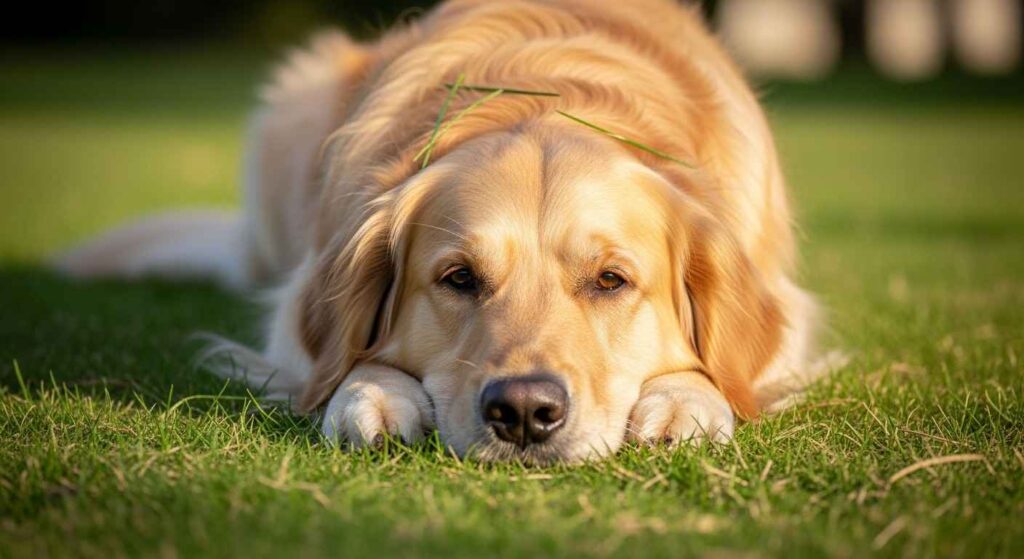
Conclusion
Every dog’s exercise needs are different. The amount of exercise your dog needs will depend on breed, age, size, and individual personality. Start with these guidelines and adjust based on your dog’s response.
Remember that mental stimulation is just as important as physical exercise. A tired dog is usually a well-behaved, happy dog.
If you’re unsure about your dog’s specific needs, consult with your veterinarian. They can help create a safe, effective exercise plan based on your dog’s health status and requirements.
For more helpful pet care information, explore our other guides on what fruits can dogs eat, how to house train your dog, and how to groom your dog at home.
Ready to find the perfect companion for your lifestyle? Try our Pet Breed Finder Quiz to discover which breeds match your activity level and living situation.
Related Tools:
- Pet Symptom Checker – Monitor your dog’s health
- Pet Age Calculator – Understand your dog’s life stage
- Pet Food Safety Checker – Ensure proper nutrition for active dogs
